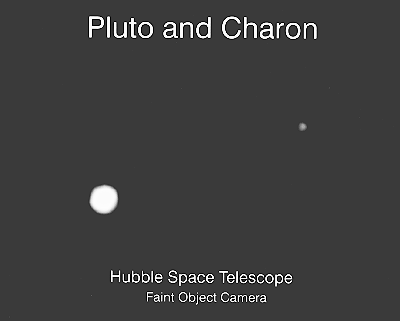
ESO Press Release 09/9418 May 1994For immediate release |
Click here to jump to photo.
The remote planet Pluto and its moon Charon orbit the Sun at a mean distance of almost 6,000 million kilometres, or nearly fourty times farther out than the Earth. During a recent investigation by an international group of astronomers [1], the best picture ever of Pluto and Charon [2] was secured with the European Space Agency's Faint Object Camera at the Hubble Space Telescope (HST). It shows the two objects as individual disks, and it is likely that further image enhancement will allow us to see surface features on Pluto.
Almost all the known facts about these two bodies show that they are quite unusual: Pluto's orbit around the Sun is much more elongated and more inclined to the main plane of the Solar System than that of any other major planet; Charon's orbit around Pluto is nearly perpendicular to this plane; their mutual distance is amazingly small when compared to their size; Charon is half the size of Pluto and the ratio of their masses is much closer to unity than is the case for all other planets and their moons. Moreover, both are small and solid bodies, in contrast to the other, large and gaseous planets in the outer Solar System.
We do not know why this is so. But there is another important aspect which makes Pluto and Charon even more interesting: at this very large distance from the Sun, any evolutionary changes happen very slowly. It is therefore likely that Pluto and Charon hold important clues to the conditions that prevailed in the early Solar System and thus to the origin and the evolution of the Solar System as a whole.
The present image shows that the overall quality of the new data obtained with the ESA Faint Object Camera on the refurbished Hubble Space Telescope is extremely good. However, such an image represents only the first step of a subsequent, detailed analysis with the ultimate goal of determining the physical properties of the two bodies, first of all their composition, surface structure and possible atmospheres.
The analysis of data from a facility as complex as the Hubble Space Telescope is very demanding, and involves experts in many different fields: planetary astronomy, instrument technology, numerical image restoration, and spacecraft engineering. It is therefore not surprising that this investigation is expected to last a long time yet.
However, while still in its preliminary stages, it already now appears to indicate the presence of areas of different reflectivity on the surface of Pluto. By a comparison of HST images obtained at two different wavelengths (i.e., in ultraviolet and visual light), the team members hope that it will become possible to construct rough maps of the planetary surface and perhaps also to answer the long-standing question of whether or not there is an atmosphere around Pluto.
[1] This investigation is carried out at the Space Telescope European Coordinating Facility, which is located at the European Southern Observatory as part of a collaboration with the European Space Agency, and also involves other institutes in Europe and the U.S.A. The team of astronomers is headed by Rudolf Albrecht (ST-ECF), and includes Hans-Martin Adorf and Richard Hook (ST-ECF), Alessandra Gemmo and Olivier Hainaut (ESO), Cesare Barbieri and Gabriele Corrain (Osservatorio Astronomico di Padova, Italy), Chris Blades, Perry Greenfield and William Sparks (Space Telescope Science Institute, Baltimore, Maryland, U.S.A.) and David Tholen (Institute for Astronomy, University of Hawaii, U.S.A.).
[2] The photo is available to the media from the ESO Information Service (address below) as ESO PR Photo 09/94-1 and from the Space Telescope Science Institute (Baltimore, USA) as STSci-PR94-17. Reproductions should be credited to NASA, ESA and ESO.

Hubble Portrait of the "Double Planet" Pluto & Charon
This is the clearest view yet of the distant planet Pluto and its moon, Charon, as revealed by the Hubble Space Telescope (HST). The image was taken by the European Space Agency's Faint Object Camera on February 21, 1994, when the planet was 4,400 million kilometres from the Earth; or nearly 30 times the separation between the Earth and the Sun.
The HST corrected optics show the two objects as clearly separate and sharp disks. This now allows astronomers to measure directly (to within about 1 percent) Pluto's diameter of 2320 kilometres and Charon's diameter of 1270 kilometres.
The HST observations show that Charon is bluer than Pluto. This means that the worlds have different surface composition and structure. A bright highlight on Pluto indicates that it may have a smoothly reflecting surface layer.
A detailed analysis of the HST image also suggests that there is a bright area parallel to the equator of Pluto. However, subsequent observations are needed to confirm is this feature is real.
Though Pluto was discovered in 1930, Charon was not detected until 1978. This is because this moon is so close to Pluto that the two world's are typically blurred together when viewed through ground-based telescopes. The new HST image was taken when Charon was near its maximum elongation from Pluto (0.9 arcseconds). The two worlds are 19,640 kilometres apart.
This photo accompanies ESO PR 09/94. It is available from ESO as ESO PR Photo 09/94-1 and from the Space Telescope Science Institute (Baltimore, USA) as STSci-PR94-17. Reproductions should be credited to NASA, ESA and ESO.
ESO Press Information is made available on the World-Wide Web (URL: http://www.eso.org/outreach/press-rel/). ESO Press Photos may be reproduced, if credit is given to the European Southern Observatory.